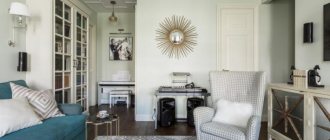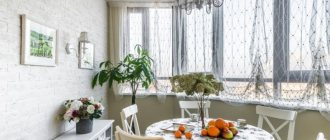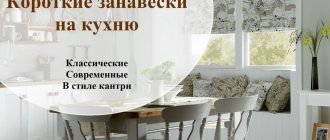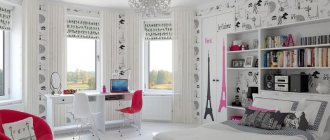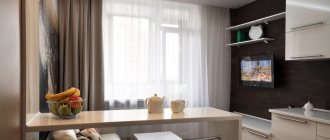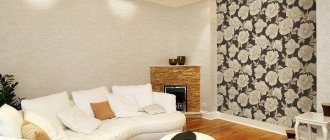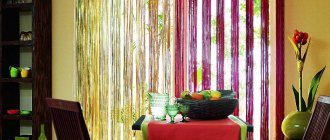[ads1] For some, a Russian-style interior is a country hut, for others, an aristocratic estate appears in their imagination, and for others, a country house. Some represent the Empire style, popular in Stalin's times, or constructivism, which was relevant in the Soviet era.
For most people, such cuisine is associated with Khokhloma painting, Gzhel and other folk ornaments and thematic decorations. But the main distinguishing feature of such an interior is the comfort of a home.
When contemplating such a design, many people feel as if they have traveled back in time.
In an effort to keep up with European trends and wanting to conform to foreign fashion, our compatriots forgot about their own roots, and many traditions sank into oblivion. But the culture of our country is very distinctive, and we need to remember its richness.
The decor of a kitchen in the original Russian style is incomparable with other styles: such interiors look surprisingly colorful.
Some call this design rustic and believe that it is similar to the ethnic style. But it contains features that do not fit into the basic concepts.
This design is distinguished by a specific ambience; the furnishings in Russian kitchens are not similar to either the currently popular country decor or the Provençal style.
Russian style is difficult to recreate precisely because of its originality. And this is not about the fact that furniture made in the traditions of Russian design is not easy to find on sale, but about established stereotypes.
Colorful nesting dolls, folk musical instruments and homemade shoes can turn the premises into a national Russian museum. It is important not to cross the line between a designer masterpiece and bad taste.
On a note! Some designers are not afraid to combine the flavor of Russian style with the functionality inherent in modern interiors. The combination of a rural setting with modern technical elements looks very unusual.
Your task is to capture the nuances and characteristic features of Russian design and not turn originality into pathos.
Style characteristics
The key feature of a kitchen interior with a native Russian design is its colorfulness; this design is difficult to confuse with any other.
In Slavic culture at all times, a lot of attention was paid to drawings and symbols. With the help of symbolism, they appeased the spirits that lived in the house and scared away evil spirits.
Drawing is the main distinguishing feature of Russian interiors. In such rooms it is everywhere: on textile elements (embroidery), furniture (intricate carved patterns), surfaces.
Drawing also found its niche in later times, closer to modern times; the ornament was transformed into national painting. We are talking about Khokhloma, haze and Gzhel.
Each of these areas has an individual color scheme and execution technique, which allows you to create a thematic design taking into account shade preferences.
This detail can also be attributed to the peculiarities of Russian design: not all styles are characterized by such diversity.
Features of arranging and decorating a kitchen in the French style: principles of style, choice of finishes, furniture, textiles, lamps, ideas for thematic decor.
A large selection of photos with Greek-style kitchen interiors can be viewed in this article.
Origin story
Despite numerous disasters, the Russian people managed to preserve their rich cultural code and pass it on to their descendants. The heritage of the Slavs also includes decoration traditions, which were appreciated by representatives of different countries.
Russian style has its roots in ancient Slavic culture, the main feature of which was modesty. There was nothing superfluous in the houses, but only what was necessary for a comfortable life: a stove, a table, benches, sleeping places. Later, images and ornaments began to appear on the walls, and dolls and crafts began to appear in the home itself.
Paganism greatly influenced the interior of the premises. The ancient Slavs believed that objects and nature were of divine origin. This was expressed in the creation of thematic carvings and decor in the form of figurines of idols. The central element of the home of the Russian stove was always kept clean and richly decorated with drawings and paintings: this is how the ancestors pacified the mythical brownie who “lived behind the stove.” Until the mid-15th century, houses were built mainly from logs from the nearby forest.
After Sophia Paleolog, the wife of Tsar Ivan III Vasilyevich, invited an architect from Italy, local craftsmen learned to build houses from stone and brick.
Decoration Materials
In each of the village areas, regardless of ethnicity, only natural materials are used.
Since ancient times, it has been the case that Russian lands were rich in forests, so wood became the main construction and finishing material for furnishing a private home. Wood is still actively used today for finishing modern interiors.
In addition to wood, textiles predominate in the design of Russian cuisine.
The table must be covered with a tablecloth, window openings are decorated with curtains, and rugs are laid on the floor. Furniture is selected with fabric upholstery.
All textile products are certainly decorated with lace and embroidery.
Advice. In a kitchen interior decorated in Russian style, it is recommended to use hand-made embroidery. The same rule applies to lace. Handmade work is easy to distinguish from factory products; Due to this, the atmosphere acquires a unique flavor.
How to decorate a country house with your own hands?
The interior becomes unique due to the decor made by yourself. It is important to think over the style of the craft so that it harmoniously complements the design of the room.
Suitable for decorating the interior of a country house:
- Coffee table made of pallets.
- Wall-shelf made of wooden boxes.
- Hanging organizer made of boards, pieces of fabric and openwork ribbons.
- Solid pouf for the veranda or attic.
Whatever the home decor, it is important that it is done with positive thoughts. It is also worth decorating country apartments with joy, enjoying the process. This is the only way to truly arrange a space where you can spend time enjoying nature.
Selecting accessories
The choice of accessories must be approached responsibly. Russian style is traditionally associated with nesting dolls and homemade bast shoes, but such things have become a stereotype, so it is better to abandon them. Today it’s bad manners.
A better solution would be bunches of garlic and onions, and beads made from dried fruits. You can emphasize the flavor of the Russian style with a spinning wheel, old Russian open shelves, and a small panel decorated with embroidery.
Wicker baskets and dishes made of painted ceramics will look original in such an interior.
Advice. Select decorative elements in accordance with the chosen direction.
For Soviet retro, aluminum dishes, porcelain products of those times, tapestry rugs, propaganda posters, posters with actors of popular films of those years, cut glasses, curtains with floral patterns, and crystal vases are suitable.
Against the background of a Russian stove, a samovar, baskets made of wicker, jugs made of clay, things decorated with Khokhloma painting, boxes made of birch bark, textiles made of linen with lace will fit into the style of a rural hut.
Decorate the kitchen, decorated in the spirit of a noble estate, with a clock with a pendulum, lighting fixtures stylized as candelabra, large vases, carpets, silver dishes, traditional porcelain dishes, and paintings depicting picturesque landscapes.
Decorate a kitchen space stylized as a Russian dacha with Zhostovo trays, airy snow-white curtains, vintage clocks, rustic lamps, old Soviet furniture, porcelain sets, and lace tablecloths.
Yasnaya Polyana
In Yasnaya Polyana, to this day there is a two-story house of Leo Tolstoy from 1800–1810 with an extension from 1871 (the author is the Tula architect Guryev). Nature is also preserved: a birch alley starting from two entrance towers; linden park of the late 18th century; landscape “Lower Park” of mixed tree species with cascading ponds; apple orchards. Adjacent to the estate are an old oak and linden grove, spruce and birch plantings planted by Lev and Sophia Tolstoy.
Color spectrum
The palette of colors for a kitchen with Russian folk design is selected based on the chosen direction. Let's consider each of the possible options in more detail.
Interesting moment! The most popular color in Russian design is red. Since ancient times, Russians believed that red symbolized beauty and wealth, so its use was necessary.
The first option for decorating a kitchen in the Russian style is Khokhloma. Its peculiarity lies in the use of contrasting solutions. The black color abruptly turns into yellow and scarlet. Intricate floral patterns give the kitchen space a cozy and warm look. Many are afraid of this design, believing that there is too much black in it, but such decor does not look depressing: it only mutes the catchy variegation of the yellow-red color scheme.
In the Gzhel direction, designs in blue tones are used. This kind of decor is close to Russian people, and complex patterns evoke positive emotions. Blue goes harmoniously with snow-white, so this palette is perfect for the kitchen area. The room will always have a warm and cozy atmosphere.
Dymkovo decor is the richest in shades. Almost the entire range of warm tones with small blue splashes is used here. A kitchen decorated with Dymkovo patterns cannot be confused with other design options: it reflects authentic Russian decor.
One of the most popular ways to recreate the Russian style involves using real wood.
It is not necessary to cover surfaces and furniture with patterns and designs: they can only be used as accents on kitchen utensils or decorative elements.
All decoration can be done in natural shades characteristic of real wood.
We advise you to choose light varieties, for example, beech or ash. Maple products are also suitable for such a kitchen. Light surfaces and furniture will make the room visually more spacious.
When creating a color palette, follow these rules:
- In the design of a small room, light and neutral shades should prevail. Variegated tones are used exclusively as accents;
- If the room has poor lighting, finish the surfaces in warm, light colors. If the windows face south, you can use a cool palette, for example, a combination of blue and white.
Decoration of premises at the dacha
There are two main options for how to decorate the premises in a dacha. The first is a unified style in the apartments. This means that one style will be used for absolutely all rooms. The second is a tribute to diversity. Each room is decorated in a different style.
Kitchen in the country
A cozy country house, like a city apartment, should always have a comfortable kitchen. Even if it is a summer guest house, there should be a corner for cooking. It is important to clearly delineate recreation areas and work space.
For finishing, lining and washable wallpaper are suitable. An abundance of flowers and pots of herbs and spices is welcome. Styles look organic: ethno, country, Provence, eco.
The living room is the gathering point for all friends
Ideally, the living room should not be cluttered with decor or furniture. The living room interior should be both practical and cozy. The presence of a fireplace and stairs is welcome (even if only as decoration).
If the housewife loves flowers, and the room is filled with sunlight, you can place a lot of flowers and plant decorations in this room. If there is a children's corner in the living room, it is worth stylizing the room accordingly, creating a safe environment for games.
Design of a relaxation area at the dacha
Interior of a living room with a brick wall at the dacha
Elements of dacha interior decor
The bedroom is a place to relax
The bedroom is a place where everyone rests and unwinds. Even the bed is placed so that there is an outlet nearby. In general, you should not overload the interior with decor. The best option for the bedroom is Provence, Scandinavian, European interior.
Veranda is a place where you can enjoy nature
The ideal option for arranging a veranda is a rustic style. The environmental concept also looks good. In general, the veranda is decorated with greenery and simple textiles - this is enough to create a cozy atmosphere. Country and chalet designs are also relevant, especially if the veranda is corner.
Bright interior of the living-dining room at the dacha
Interior design of a dacha
Colonial style cottage interior
Toilet and bathroom
The bathroom and toilet also deserve attention. If the bathroom has a shower, you can experiment with the loft style, modern classics or rustic style. The bathtub is the central element for interior compositions in Japanese and Provence style.
Kitchenware and household appliances
Kitchen utensils are one of the most important nuances of decorating a kitchen in the Russian style. It is used to place accents; thanks to the dishes, a special atmosphere is created.
Preference should be given to ceramic dishes, jugs and plates with painted patterns, and pottery.
Wooden spoons will fit well into such an interior, but such kitchen utensils are impractical, so they serve only a decorative function.
Nowadays, many retail outlets sell Russian-style kitchen utensils; finding such products is not difficult. Selecting household appliances will be more difficult.
When mentioning the Russian style, many immediately think of the stove. But in modern interiors, stone and brick stoves are a rarity, especially in apartments.
You can replace such equipment with a hood in the appropriate style - make it to order or look for a suitable option in stores.
A good solution for Russian cuisine is to replace the usual kettle with a metal samovar. Many years ago, samovars were in every home; tea drinking was unimaginable without them.
You can buy an electric model, but definitely brass or painted in the appropriate shade.
Modern household appliances must be put away in cabinets and cabinets so that they do not spoil the overall picture.
What varieties are known?
Russian style reflects the desire to return to one's roots and respect history in all aspects. The historical past is considered in the totality of seemingly incompatible elements. For example, wooden tables and benches complement plush beds with luxurious canopies that came to Russia from the West. During the reign of Peter the Great, Russian homes underwent many changes, absorbing European features.
The spread of fashionable country style at the end of the 20th century again attracted the attention of Russians to the colorful Russian style. A sincere desire to give your apartment or house the look of an authentic Russian hut appeared in the 90s of the last century, and today this design decision is reflected in the homes of Russians. Read

